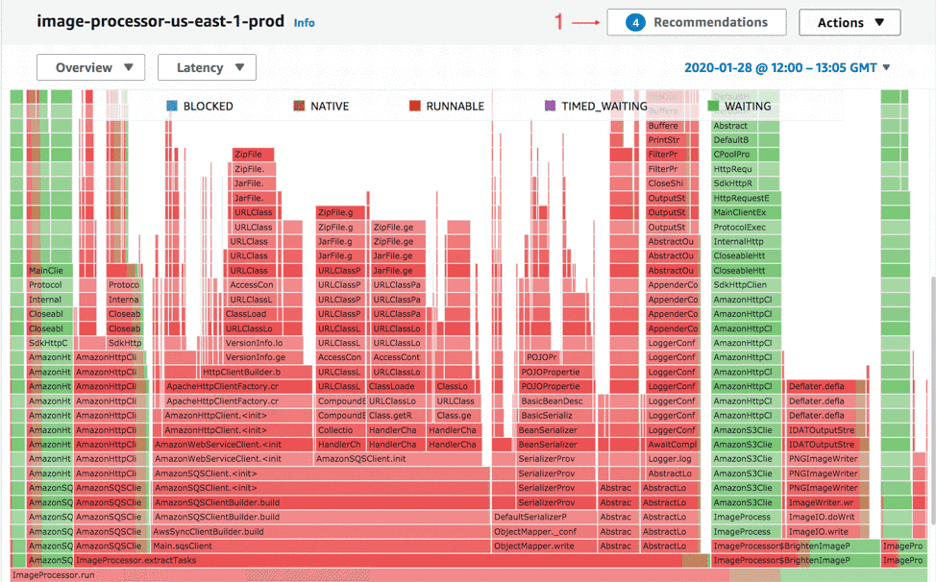This post explores how Amazon CodeWhisperer can help with code optimization for sustainability through increased resource efficiency. Computationally resource-efficient coding is one technique that aims to reduce the amount of energy required to process a line of code and, as a result, aid companies in consuming less energy overall. In this era of cloud computing, developers are now harnessing open source libraries and advanced processing power available to them to build out large-scale microservices that need to be operationally efficient, performant, and resilient. However, modern applications often consist of extensive code, demanding significant computing resources. Although the direct environmental impact might not be obvious, sub-optimized code amplifies the carbon footprint of modern applications through factors like heightened energy consumption, prolonged hardware usage, and outdated algorithms. In this post, we discover how Amazon CodeWhisperer helps address these concerns and reduce the environmental footprint of your code.
Amazon CodeWhisperer is a generative AI coding companion that speeds up software development by making suggestions based on the existing code and natural language comments, reducing the overall development effort and freeing up time for brainstorming, solving complex problems, and authoring differentiated code. Amazon CodeWhisperer can help developers streamline their workflows, enhance code quality, build stronger security postures, generate robust test suites, and write computationally resource friendly code, which can help you optimize for environmental sustainability. It is available as part of the Toolkit for Visual Studio Code, AWS Cloud9, JupyterLab, Amazon SageMaker Studio, AWS Lambda, AWS Glue, and JetBrains IntelliJ IDEA. Amazon CodeWhisperer currently supports Python, Java, JavaScript, TypeScript, C#, Go, Rust, PHP, Ruby, Kotlin, C, C++, Shell scripting, SQL, and Scala.
Impact of unoptimized code on cloud computing and application carbon footprint
AWS’s infrastructure is 3.6 times more energy efficient than the median of surveyed US enterprise data centers and up to 5 times more energy efficient than the average European enterprise data center. Therefore, AWS can help lower the workload carbon footprint up to 96%. You can now use Amazon CodeWhisperer to write quality code with reduced resource usage and energy consumption, and meet scalability objectives while benefiting from AWS energy efficient infrastructure.
Increased resource usage
Unoptimized code can result in the ineffective usage of cloud computing resources. As a result, more virtual machines (VMs) or containers may be required, increasing resource allocation, energy use, and the related carbon footprint of the workload. You might encounter increases in the following:
- CPU utilization – Unoptimized code often contains inefficient algorithms or coding practices that require excessive CPU cycles to run.
- Memory consumption – Inefficient memory management in unoptimized code can result in unnecessary memory allocation, deallocation, or data duplication.
- Disk I/O operations – Inefficient code can perform excessive input/output (I/O) operations. For example, if data is read from or written to disk more frequently than necessary, it can increase disk I/O utilization and latency.
- Network usage – Due to ineffective data transmission techniques or duplicate communication, poorly optimized code may cause an excessive amount of network traffic. This can lead to higher latency and increased network bandwidth utilization. Increased network utilization may result in higher expenses and resource needs in situations where network resources are taxed based on usage, such as in cloud computing.
Higher energy consumption
Infrastructure-supporting applications with inefficient code uses more processing power. Overusing computing resources due to inefficient, bloated code can result in higher energy consumption and heat production, which subsequently necessitates more energy for cooling. Along with the servers, the cooling systems, the infrastructure for power distribution, and other auxiliary elements also consume energy.
Scalability challenges
In application development, scalability issues can be caused by unoptimized code. Such code may not scale effectively as the task grows, necessitating more resources and using more energy. This increases the energy consumed by these code fragments. As mentioned previously, inefficient or wasteful code has a compounding effect at scale.
The compounded energy savings from optimizing code that customers run in certain data centers is even further compounded when we take into consideration that cloud providers such as AWS have dozens of data centers around the world.
Amazon CodeWhisperer uses machine learning (ML) and large language models to provide code recommendations in real time based on the original code and natural language comments, and provides code recommendations that could be more efficient. The program’s infrastructure usage efficiency can be increased by optimizing the code using strategies including algorithmic advancements, effective memory management, and a reduction in pointless I/O operations.
Code generation, completion, and suggestions
Let’s examine several situations where Amazon CodeWhisperer can be useful.
By automating the development of repetitive or complex code, code generation tools minimize the possibility of human error while focusing on platform-specific optimizations. By using established patterns or templates, these programs may produce code that more consistently adheres to sustainability best practices. Developers can produce code that complies with particular coding standards, helping deliver more consistent and dependable code throughout the project. The resulting code may be more efficient and because it removes human coding variations, and can be more legible, improving development speed. It can automatically implement ways to reduce the application program size and length, such as deleting superfluous code, improving variable storage, or using compression methods. These optimizations can aid in memory consumption optimization and boosts overall system efficiency by shrinking the package size.
Generative AI has the potential to make programming more sustainable by optimizing resource allocation. Looking holistically at an application’s carbon footprint is important. Tools like Amazon CodeGuru Profiler can collect performance data to optimize latency between components. The profiling service examines code runs and identifies potential improvements. Developers can then manually refine the auto generated code based on these findings to further improve energy efficiency. The combination of generative AI, profiling, and human oversight creates a feedback loop that can continuously improve code efficiency and reduce environmental impact.
The following screenshot shows you results generated from CodeGuru Profiler in latency mode, which includes network and disk I/O. In this case, the application still spends most of its time in ImageProcessor.extractTasks (second bottom row), and almost all the time inside that is runnable, which means that it wasn’t waiting for anything. You can view these thread states by changing to latency mode from CPU mode. This can help you get a good idea of what is impacting the wall clock time of the application. For more information, refer to Reducing Your Organization’s Carbon Footprint with Amazon CodeGuru Profiler.

Generating test cases
Amazon CodeWhisperer can help suggest test cases and verify the code’s functionality by considering boundary values, edge cases, and other potential issues that may need to be tested. Also, Amazon CodeWhisperer can simplify creating repetitive code for unit testing. For example, if you need to create sample data using INSERT statements, Amazon CodeWhisperer can generate the necessary inserts based on a pattern. The overall resource requirements for software testing can also be decreased by identifying and optimizing resource-intensive test cases or removing redundant ones. Improved test suites have the potential to make the application become more environmentally friendly by increasing energy efficiency, decreasing resource consumption, minimizing waste, and reducing the workload carbon footprint.
For a more hands-on experience with Amazon CodeWhisperer, refer to Optimize software development with Amazon CodeWhisperer. The post showcases the code recommendations from Amazon CodeWhisperer in Amazon SageMaker Studio. It also demonstrates the suggested code based on comments for loading and analyzing a dataset.
Conclusion
In this post, we learned how Amazon CodeWhisperer can help developers write optimized, more sustainable code. Using advanced ML models, Amazon CodeWhisperer analyzes your code and provides personalized recommendations for improving efficiency, which can reduce costs and help decrease the carbon footprint.
By suggesting minor adjustments and alternative approaches, Amazon CodeWhisperer enables developers to significantly cut resource usage and emissions without sacrificing functionality. Whether you’re looking to optimize an existing code base or ensure new projects are resource efficient, Amazon CodeWhisperer can be an invaluable aid. To learn more about Amazon CodeWhisperer and AWS Sustainability resources for code optimization, consider the following next steps:
About the authors
 Isha Dua is a Senior Solutions Architect based in the San Francisco Bay Area. She helps AWS enterprise customers grow by understanding their goals and challenges, and guides them on how they can architect their applications in a cloud-native manner while ensuring resilience and scalability. She’s passionate about machine learning technologies and environmental sustainability.
Isha Dua is a Senior Solutions Architect based in the San Francisco Bay Area. She helps AWS enterprise customers grow by understanding their goals and challenges, and guides them on how they can architect their applications in a cloud-native manner while ensuring resilience and scalability. She’s passionate about machine learning technologies and environmental sustainability.
 Ajjay Govindaram is a Senior Solutions Architect at AWS. He works with strategic customers who are using AI/ML to solve complex business problems. His experience lies in providing technical direction as well as design assistance for modest to large-scale AI/ML application deployments. His knowledge ranges from application architecture to big data, analytics, and machine learning. He enjoys listening to music while resting, experiencing the outdoors, and spending time with his loved ones.
Ajjay Govindaram is a Senior Solutions Architect at AWS. He works with strategic customers who are using AI/ML to solve complex business problems. His experience lies in providing technical direction as well as design assistance for modest to large-scale AI/ML application deployments. His knowledge ranges from application architecture to big data, analytics, and machine learning. He enjoys listening to music while resting, experiencing the outdoors, and spending time with his loved ones.
 Erick Irigoyen is a Solutions Architect at Amazon Web Services focusing on clients in the Semiconductors and Electronics industry. He works closely with customers to understand their business challenges and identify how AWS can be leveraged to achieve their strategic goals. His work has primarily focused on projects related to Artificial Intelligence and Machine Learning (AI/ML). Prior to joining AWS, he was a Senior Consultant at Deloitte’s Advanced Analytics practice where he led workstreams in several engagements across the United States focusing on Analytics and AI/ML. Erick holds a B.S. in Business from the University of San Francisco and an M.S. in Analytics from North Carolina State University.
Erick Irigoyen is a Solutions Architect at Amazon Web Services focusing on clients in the Semiconductors and Electronics industry. He works closely with customers to understand their business challenges and identify how AWS can be leveraged to achieve their strategic goals. His work has primarily focused on projects related to Artificial Intelligence and Machine Learning (AI/ML). Prior to joining AWS, he was a Senior Consultant at Deloitte’s Advanced Analytics practice where he led workstreams in several engagements across the United States focusing on Analytics and AI/ML. Erick holds a B.S. in Business from the University of San Francisco and an M.S. in Analytics from North Carolina State University.
- SEO Powered Content & PR Distribution. Get Amplified Today.
- PlatoData.Network Vertical Generative Ai. Empower Yourself. Access Here.
- PlatoAiStream. Web3 Intelligence. Knowledge Amplified. Access Here.
- PlatoESG. Carbon, CleanTech, Energy, Environment, Solar, Waste Management. Access Here.
- PlatoHealth. Biotech and Clinical Trials Intelligence. Access Here.
- Source: https://aws.amazon.com/blogs/machine-learning/optimize-for-sustainability-with-amazon-codewhisperer/



